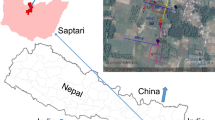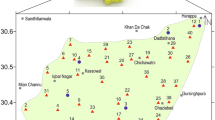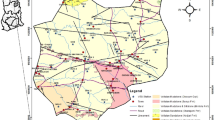Abstract
Transmissivity and hydraulic conductivity are essential parameters for understanding the behavior and characteristics of aquifers, and useful for framing of ground water sustainability and management aspects. After well construction and subsequent analysis of pumping test data (PTDA), the aquifer parameters can be determined. In the study area, the drilling methods are not anticipated for construction of tube wells uniformly, but the area has an ideal ground water recharge and flow conditions. The hydrogeological data gaps of aquifer parameters are observed in the study area. Keeping in view, the database is generated by using geo-electrical resistivity survey. Further, these are validated with ground truth (limited hydrogeological studies of yield test, existing lithological, and transmissivity data), and in this queue, other researchers had not yet been discussed for this type of terrain. The authors discussed the importance of geophysical results for generation of hydrogeological data without drilling and said about the optimal time saving, labor costs, and financial burdens. The study area is categorized in two segments based on the geological variations—Siwalik piedmont area (zone 1) and alluvial plains (zone 2). There were 30 numbers of vertical electrical soundings (VES) conducted in the area and resulted to derive the aquifer disposition and aquifer parameter (modeled transmissivity “T”). The VES-based modeled transmissivity (T) value trend follows < 1000m2/day (Siwaliks), 1000–3000 m2/day (alluvial plains), whereas the aquifer potential yield ranges are observed < 1000 lpm (Siwaliks) and 1000–1500 lpm (alluvial plains), respectively. The validated results reveal that that an aquifer’s yield/discharge rate is proportional to the “T” component and also beneficial for producing hydrogeological data without drilling.













Similar content being viewed by others
References
Abdullahi NK, Udensi EE (2008) Estimating aquifer transmissivity from geo-electrical sounding. J Environ 3(1). https://doi.org/10.4314/fje.v3i1.50804
Anantha Rao D, Naik PK, Jain SK, Vinod Kumar K, DhanamjayaRao EN (2018) Assessment of vulnerability zones for ground water pollution using GIS-DRASTIC-EC model: a field-based approach. J Earth Syst Sci 127:49. https://doi.org/10.1007/s12040-018-0944-1
Arshad M, Shakoor A, Ahmad I, Ahmad M (2013) Hydraulic transmissivity determination for the ground water exploration using vertical electric sounding method in comparison to the traditional methods”. Pak J Agri Sci 50(3):487–492
Bhatnagar NC, Agashe RM, Mishra AK (1982) Subsurface mapping of aquifer system: water balance study of Upper Yamuna Basin. Section-Hydrogeology, Technical report No.2, Upper Yamuna Project: CGWB, NWR region, Chandigarh
Frohlich RK, Kelly WE (1985) The relation between hydraulic transmissivity and transverse resistance in a complicated aquifer of glacial outwash deposits. J Hydrol 79(3–4):529–556. https://doi.org/10.1016/0022-1694(85)90056-3
Gajbhiye NG et al (1987) Hydrogeological investigations and surveys-an unpublished report of CGWB-NCR. Bhupal, India
GSI, Geological Survey of India (2015) Geological Map of Yamuna Nagar district, Haryana state on 1:50000 scale
Ground Water Cell (GWC), Department of Irrigation & Water Resources, Haryana & Central Ground Water Board (CGWB), Chandigarh (2021) Report on Dynamic Ground Water Resources of Haryana State, 2020. Ground Water Cell, Agriculture & FW Department, Govt. of Haryana and Central Ground Water Board, North Western Region, Chandigarh
Indian Meteorological Department (IMD) (2015) Ministry of Earth Sciences. Rainfall data for Yamuna Nagar district, Haryana state. www.imd.gov.in/section/hydro/distrainfall/webrain/haryana/yamunanagar.txt
Khalil MA, Fernando A, Monterio S (2009) Influence of degree of saturation in the electric resistivity– hydraulic conductivity relationship. Surv Geophys 30:601–615
Kumar R, Bhattacharya S (2007) To study heavy mineral suites and correlate the sedimentation patterns within Siwalik group of rocks in Ambala and Yamuna Nagar districts, Haryana, FS-2007–08, Petrology Division, Geological Survey of India, Northern Region, Faridabad
Micro Irrigation Census (MIC) (2006–07) http://www.micensus.gov.in/Yamuna Nagar district (2006–07)
NBSS & LUP (National Bureau of Soil Survey and Land Use Planning) (State, 1994.) (2010) Soil Map of the Haryana State. Publications of National Bureau of Soil Survey and Land Use Planning (ICAR) and Department of Agriculture, Haryana
Niwas S, Singhal DC (1981) Estimation of aquifer transmissivity from Dar Zarrouk parameters in porous media. Hydrology 50:393–399. https://doi.org/10.1016/0022-1694(81)90082-2
NRSC-GSI (National Remote Sensing Centre – Geological Survey of India) (2010) Manual for Geomorphological & Lineament Mapping on 1:50000 scale and Schema Development. National Remote Sensing Centre and Geological Survey of India combined Project
NRSC-ISRO (National Remote Sensing Centre–Indian Space Research Organization) (2008) Data accessed and downloaded for preparation of elevation map (Cartosat-1 Data: C1_DEM_16b_2006-2008_V1_77E30N_H43L). Retrieved from http://bhuvan.nrsc.gov.in/data/download/index.php
NRSC-ISRO (National Remote Sensing Centre–Indian Space Research Organization) (2012) Land Use Land Cover (1:50000 scale). Data accessed and download from http://bhuvan.nrsc.gov.in/gis/thematic/index.php
Okoro EI, Egboka BCE, Onwuemesi AG (2010) Evaluation of the aquifer characteristic of Nanka Sands using hydrogeological method in combination with vertical electrical sounding (VES). J Appl Sci Environ Manag 14(2):5–9
Sattar GS, Keramat M, Shahid S (2016) Deciphering transmissivity and hydraulic conductivity of the aquifer by vertical electrical sounding (VES) experiments in Northwest Bangladesh. Appl Water Sci 6:35–45. https://doi.org/10.1007/s13201-014-0203-9
Senthil Kumar M, Gnanasunda D, Elango L (2001) Geophysical Studies to determine hydraulic characteristics of an alluvial aquifer. J Environ Hydrol 9:1–8
Verma BC (1976) Geological mapping and systematic collection of vertebrate fossils and stone artefacts from the Upper Siwalik Formation and Yamuna River terraces of Solan and Sirmur districts of H.P and Rupar district of Punjab, Unpublished Report, Geological Survey of India. F.S. 1974–75
Acknowledgements
The authors thank Dr. S. K. Jain, Regional Director, Central Ground Water Board (CGWB), Chandigarh, for encouraging to publish this work. The authors thank Dr. Shailesh Bhatnagar, Jr., geophysicist, for his valuable support during the study and thank to hydrogeologists of CGWB, North Western Region, CGWB, Chandigarh, for the valuable support in technical discussions. Special thanks to Dr. Sashikanth, Jr., geophysicist, Dr. F. Alam, and Dr. P.K. Nayak, Scientist-D, for their technical advises and suggestions during the preparation of the reports. Thanks are also due to Dr. B. K. Purandara for his overall encouragement and moral support during preparation of technical reports. The authors are thanked and highly acknowledged to reviewers and editor-in-chief of Arabian Journal of Geosciences, as well as the entire team of the esteemed journal for their constructive help during peer review of this publication.
Author information
Authors and Affiliations
Corresponding author
Ethics declarations
Conflict of interest
The authors have no conflicts of interest and no funding sources for this research study, which has been submitted in the manuscript to this esteemed journal.
Additional information
Responsible Editor: Broder J. Merkel
Rights and permissions
Springer Nature or its licensor (e.g. a society or other partner) holds exclusive rights to this article under a publishing agreement with the author(s) or other rightsholder(s); author self-archiving of the accepted manuscript version of this article is solely governed by the terms of such publishing agreement and applicable law.
About this article
Cite this article
Duragasi, A.R., Sukumaran, J.V. Geo-electrical resistivity–based study to estimate the aquifer parameters—a study in parts of Yamuna Nagar District, Haryana State, North India. Arab J Geosci 16, 584 (2023). https://doi.org/10.1007/s12517-023-11691-9
Received:
Accepted:
Published:
DOI: https://doi.org/10.1007/s12517-023-11691-9




